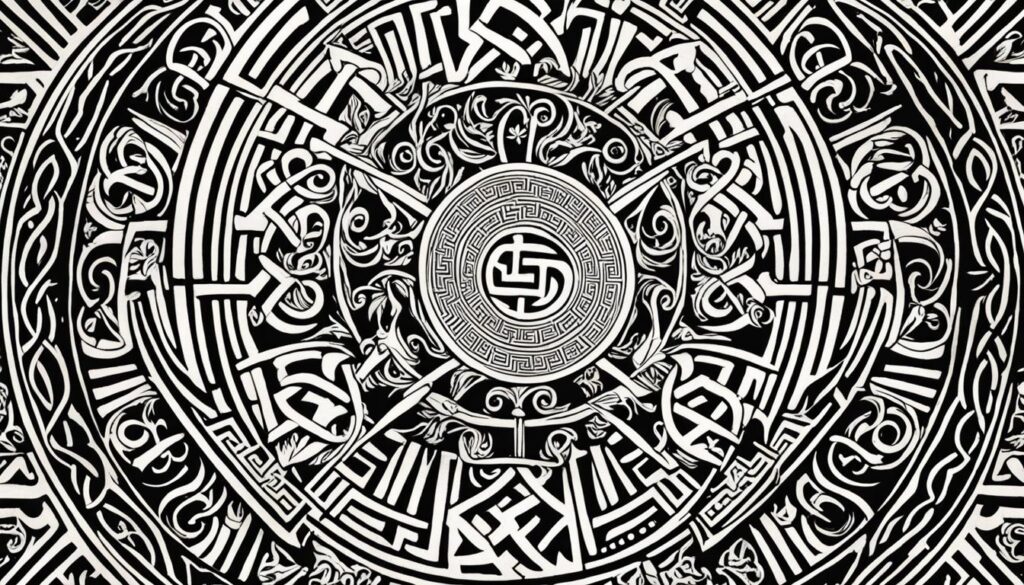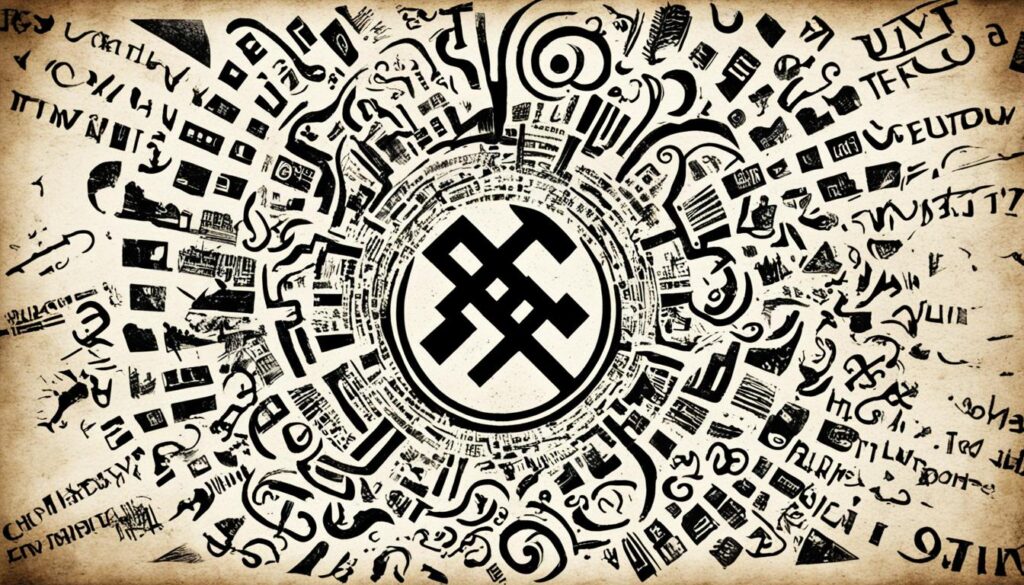When you hear the word “swastika,” what comes to mind? For most people, it’s the chilling image of the Nazi flag and the atrocities committed during World War Two. But did you know that the swastika has a rich and diverse history that extends far beyond its association with Nazi Germany?
The swastika is a symbol with ancient origins, dating back over 7000 years. The word “swastika” itself comes from the Sanskrit svastika, which means “good fortune” or “well-being.” It has deep religious and cultural significance in Hinduism, Buddhism, Jainism, and Odinism. The symbol can be seen on temples, houses, and religious artifacts in India and Indonesia.
But the swastika’s influence isn’t limited to eastern cultures. It has also played a role in European history, appearing on artifacts from pre-Christian European cultures. In fact, the symbol was widely used in Europe before the rise of the Nazis.
So, what is the true meaning and significance of the swastika? How did it become tangled with one of the darkest chapters in human history? And can we separate the symbol from its association with hate and genocide?
Key Takeaways:
- The swastika has ancient origins and is found in many cultures around the world.
- It has deep religious and cultural significance in Hinduism, Buddhism, Jainism, and Odinism.
- The swastika was widely used in Europe before the Nazi appropriation.
- Understanding the true meaning and significance of the swastika challenges common beliefs associated with it.
- The swastika’s complex history and cultural connotations make it a controversial symbol.
The Resurgence and Adaptation of the Swastika in Europe
In the nineteenth century, the swastika experienced a resurgence in Europe, as scholars and thinkers became fascinated with the ancient civilizations of the Near East and India. This newfound interest led to the adoption of the swastika as a symbol in various aspects of European culture.
Architects incorporated the swastika as an architectural motif, adorning buildings, temples, and monuments with its intricate and symmetrical design. The symbol also found its way into advertising and product design, where its association with positive meanings such as good luck and prosperity made it an appealing choice.
Well-known brands like Coca-Cola and Carlsberg even incorporated the swastika into their logos, capitalizing on its positive connotations and timeless significance. The swastika’s presence in popular culture was not limited to Europe; American military units during World War One embraced the symbol, and it could be seen on Royal Air Force (RAF) planes until 1939.
This image showcases the swastika’s widespread adaptation in European culture during the early twentieth century.
However, the benign uses of the swastika came to a halt in the 1930s with the rise of the Nazis in Germany. The swastika, once a symbol of good luck and well-being, was transformed into a powerful tool of propaganda and hate, forever altering its perception in the Western world.
The Nazi Appropriation of the Swastika
The swastika, once a symbol of prosperity and well-being, unfortunately became synonymous with hate and Nazi ideology during the 20th century. The Nazi Party adopted the swastika as its primary symbol in 1920, leveraging its ancient association with Aryan cultural heritage to bolster a sense of Aryan identity and German nationalism.
The swastika quickly became emblematic of Nazi propaganda, adorning the infamous Nazi flag and spreading across election posters, arm bands, medallions, and badges. This once benign symbol took on new meaning, representing the concept of racial purity and the envisioned creation of a racially “pure” state. The swastika became a powerful tool for the Nazis to rally their followers and instill fear among their perceived enemies.
Here is an overview of the key aspects of the swastika’s Nazi appropriation:
- Symbol of Aryan Identity: The Nazis adopted the swastika as a visual representation of their belief in the superiority of the Aryan race. By associating themselves with this ancient symbol, they aimed to strengthen their claim to a mythical Aryan cultural heritage.
- Icon of German Nationalism: The swastika’s adoption as the Nazi Party’s symbol also tied it closely to German nationalism. The Nazis sought to evoke a sense of pride and unity among the German people, rallying them under the banner of the swastika.
- Propaganda Powerhouse: The swastika’s prominence in Nazi propaganda ensured its widespread visibility and recognition. It became an inseparable part of the Nazi regime’s messaging, invoking both loyalty and fear.
The Swastika as a Symbol of Aryan Identity
The swastika’s appropriation by the Nazis aimed to promote their ideology of Aryan racial superiority. The association with the Aryan identity served as a powerful tool for the Nazi Party in asserting their alleged heritage and justifying their supremacist beliefs. By linking the swastika to the Aryan concept, the Nazis sought to establish a sense of pride and exclusivity among their followers, fostering a shared identity centered around racial purity.
The Swastika as a Symbol of German Nationalism
In addition to symbolizing Aryan identity, the swastika became closely intertwined with German nationalism during the rise of the Nazi Party. By aligning the swastika with German pride and the vision of a racially homogeneous state, the Nazis tapped into the nationalistic sentiments of the German population, further galvanizing their support. The swastika served as a rallying point, representing unity and the shared destiny of the German people.

| Symbol | Meaning |
|---|---|
| Swastika | Originally a symbol of good fortune and well-being in various cultures |
| Swastika under Nazi appropriation | Became a symbol of Aryan identity and German nationalism, representing racial purity |
The Swastika in Nazi Germany
After taking power in 1933, Hitler’s regime replaced the black-red-gold flag of the Weimar Republic with the swastika flag, symbolizing Germany’s powerful rebirth and the solidarity of the German people. The swastika became a potent symbol intended to elicit pride among Aryans, but it also struck fear in Jews and others deemed enemies of Nazi Germany. The use of Nazi symbols and propaganda, including the swastika, was banned in Germany after World War Two.

| Nazi Propaganda | Use of Swastika in Nazi Organizations |
|---|---|
|
|
The Swastika’s Ancient Origins and European Presence
The swastika symbol, commonly associated with Nazi Germany, has roots that extend beyond its infamous history. While often regarded as an Indian symbol, archaeological finds have revealed the swastika’s ancient origins in various cultures worldwide. Notably, the swastika held significance in Greek and Celtic cultures, as well as in Eastern Europe.
Ancient Past: Swastika’s Global Journey
In addition to its association with Hinduism and Buddhism, the swastika symbol was used by the Ancient Greeks, Celts, and Anglo-Saxons. These civilizations incorporated the swastika into their art, architecture, and cultural practices, recognizing its potential as a powerful symbol of prosperity and well-being.
Eastern European Presence:
Eastern Europe holds some of the oldest examples of the swastika. From the Baltic to the Balkans, intricate swastika motifs can be found in meander patterns and architectural ornaments. These discoveries unveil the deep roots of the swastika in European culture and highlight its ancient significance in the region.
To further understand the origins and impact of the swastika, it is crucial to explore its presence in diverse cultures and acknowledge its complex history. By doing so, we can develop a more comprehensive understanding of this ancient symbol and its multifaceted meanings.

Contemporary Views and Controversies Surrounding the Swastika
In the aftermath of World War II, several European countries, including Germany, enacted laws to ban the public display of Nazi symbols, including the swastika. These bans aim to prevent the promotion of hate speech and the revival of fascist ideologies. Germany, in particular, has implemented strict legislation in order to combat the horrors of the past and ensure that such symbols are not glorified or used to spread division and discrimination.
However, in the United States, where freedom of speech is protected by the First Amendment, the public display of Nazi symbols, including the swastika, is still legal. This has led to ongoing debates and controversies surrounding the balance between freedom of expression and the potential harm caused by these symbols.
It is important to note that while the swastika is synonymous with Nazi ideology and associated with unimaginable atrocities, it has also taken on alternative meanings in certain subcultures. Some motorcycle gangs and punk rock performers, for example, have adopted the swastika as a symbol of rebellion, often divorced from its historical context. This appropriation of the swastika further adds to its controversial nature and the varied interpretations it can evoke.
The swastika’s complex history, spanning thousands of years and different cultures, contributes to its status as a deeply controversial symbol. While it is essential to acknowledge the immense pain and suffering caused by its association with the Nazi regime, discussions surrounding the swastika should also consider its origins as a symbol of positive meanings such as well-being and good fortune. Striking a balance between recognizing the swastika’s historical significance and condemning its misuse remains an ongoing challenge.

Overall, the swastika is a symbol that elicits powerful emotions and raises important questions about the limits of free speech, the role of historical context, and the responsibility to prevent the propagation of hate and harmful ideologies. By engaging in thoughtful and respectful dialogue, society can navigate the complexities surrounding the swastika and work toward creating a more inclusive and understanding future.
Conclusion
The swastika symbol has a complex and rich history that extends far beyond its association with the Nazi regime. It has been an integral part of various cultures worldwide for thousands of years, representing themes such as good fortune, well-being, and cultural identity.
While the horrors of fascism have understandably made the swastika a symbol of fear and pure evil for many, it is essential to acknowledge its long multicultural past. Efforts are being made to reclaim and educate the public about the true meanings and origins of the swastika, allowing for a greater understanding and appreciation of its diverse significance.
By challenging conventional perceptions and delving into the swastika’s ancient roots, we can foster a more nuanced understanding of this ancient symbol. It is through education and open-mindedness that we can reshape the narrative surrounding the swastika and acknowledge its significance to numerous cultures throughout history.
FAQ
What is the swastika?
The swastika is a symbol that has ancient origins and has been used in various cultures. It is a cross with arms that are bent at right angles, resembling a spinning wheel or a spiral.
What is the significance of the swastika?
The swastika has different meanings in different cultures. In Hinduism, Buddhism, Jainism, and Odinism, it is a symbol of good fortune and well-being. It has also been associated with strength, life, and the sun.
What is the history of the swastika?
The swastika has a long history, dating back about 7000 years. It has been found on artifacts from ancient civilizations in Europe, India, and other parts of the world. In the 19th century, it experienced a resurgence in Europe as a symbol of cultural and artistic interest.
Why is the swastika controversial?
The swastika became highly controversial due to its association with Nazi Germany and the atrocities committed during World War Two. It is seen as a symbol of hate, racism, and oppression by many people today.
Is it legal to display the swastika?
The legality of displaying the swastika varies by country. In Germany and some European countries, it is illegal to display Nazi symbols, including the swastika, due to their association with the Holocaust. In the United States, it is generally legal to display the swastika due to free speech protections.
Can the swastika be reclaimed as a positive symbol?
There are ongoing efforts to reclaim and educate the public about the true meanings and multicultural origins of the swastika. Some individuals and organizations seek to separate it from its association with Nazi ideology and appreciate its historical and cultural significance.

